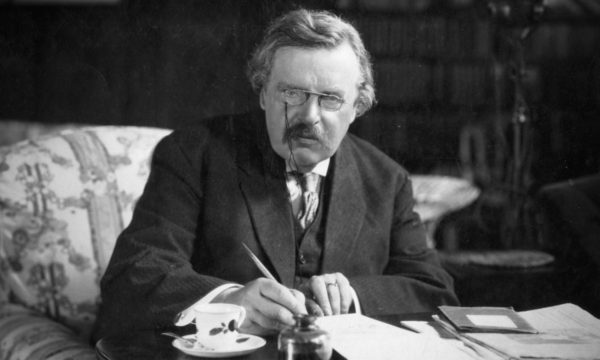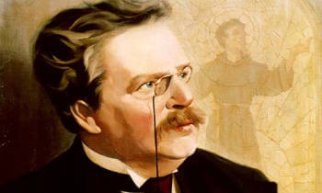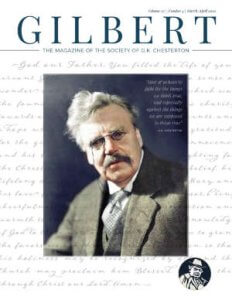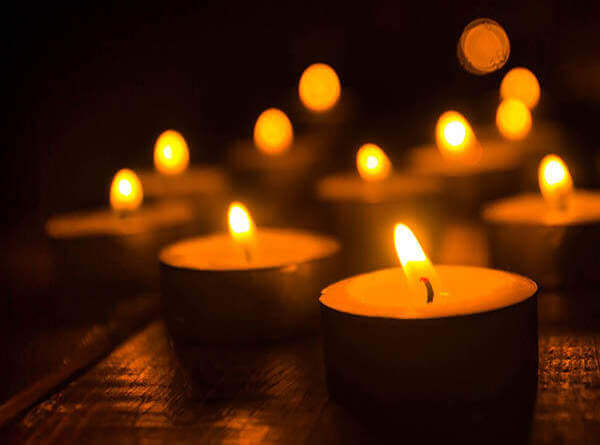It may surprise some to know that Chesterton was raised as a Unitarian. His discovery of “orthodox” Christianity (as described in his book Orthodoxy), led him first to the Church of England in 1901, which he said later was simply his own uncompleted conversion to Catholicism. Before becoming Catholic, Chesterton acknowledged the fact that he was ushering many others into the Church without having entered it himself. He is still ushering them in. It was not until 1922, at the age of 48, when Chesterton was received into the Roman Catholic Church. This came as a shock to many. Casual observers were surprised because they thought he already was Catholic, since he’d been defending the Church for years. But many who knew him better, among both his allies and his opponents, thought it would simply never happen. George Bernard Shaw fired off a letter: “Gilbert, this is going too far.”
Five years after he finally entered the Church, Chesterton wrote The Catholic Church and Conversion. He says that although all roads lead to Rome, each pilgrim is tempted to talk as if all roads had been like his own road. “The Church is a house with a hundred gates; and no two men enter at exactly the same angle.” But he needn’t have worried about making too personal a statement. Almost every convert will recognize the three stages of conversion that Chesterton describes: The first stage is, Patronizing the Church. The second, Discovering the Church. And the third is… running away from the Church.
The convert takes his first step rather unwittingly when he decides he’s going to be fair to the Catholic Church. He does not think the Roman religion is true, but for the first time, he also doesn’t think that the accusations against the Church are true. This important first step leads to a long and enjoyable second step, which is the utter fascination of learning what the Catholic Church really does teach. Chesterton says this is the most pleasant part of the business, “easier than joining the Catholic Church and much easier than trying to live the Catholic life. It is like discovering a new continent full of strange flowers and fantastic animals, which is at once wild and hospitable.” But then the convert suddenly realizes with a shock that he can no longer be detached and impartial about the Catholic Church.
It is impossible to be just to the Catholic Church. The moment a man ceases to pull against it he feels a tug towards it. The moment he ceases to shout it down he begins to listen to it with pleasure. The moment he tries to be fair to it he begins to be fond of it.
But then comes the final stage: fear. “It’s one thing,” says Chesterton, “to conclude that Catholicism is good and another to conclude that it is right. It is one thing to conclude that is right and another to conclude that it is always right.” At that delicate last stage, Chesterton observes that it is no longer the Church’s enemies who are holding the convert back, but “only the word of a Catholic can keep him from Catholicism. One foolish word from inside does more harm than a hundred thousand foolish words from outside.” He points out a problem that plagues the Church still: Catholics who not only do a very poor job of presenting their faith, but actually manage to repel converts who are pounding on the door trying to get in. Every Catholic would do well to read this book. Besides being better equipped to deal with converts, they would have a deeper appreciation of the faith in which they were formed. Especially the realization that the Church, as Chesterton say, “is larger on the inside than it is on the outside.”
Every era tries to create a new religion, something more befitting the age, but new religions are only suited to what is new. And what is new is soon old. Chesterton argues that the Catholic Church has all the freshness of a new religion, but it also has the richness of an old religion. It does not change with people’s tastes. It is a religion that binds men to their morality even when they are not in the mood to be moral. The Church often has to go against the grain of the world. It has preached social reconciliation to fierce and raging factions who would much rather destroy each other. It preached Charity to the old pagans who did not believe in it, just as it now preaches chastity to the new pagans who do not believe in it.
We do not really need a religion that is right where we are right. What we need is a religion that is right where we are wrong.
Chesterton had already proved himself a champion of tradition against faddism, but he made it clear to his doubters and detractors that one of the main reasons for becoming Catholic was that Catholic Church “is the only thing that saves a man from the degrading slavery of being a child of his age.” He found everything else narrower and more restrictive. In the Church he found freedom. Dizzying freedom, he claimed. If that is not surprising enough, it should be sobering if not stunning to any honest reader of Chesterton to consider that this intellectual giant found a home for his mind in the Catholic Church. Not a home as a place merely to rest, but as a place of great activity and excitement. This is revealed in one of the most challenging statements Chesterton ever made: “To become a Catholic is not to leave off thinking, but to learn how to think.”





